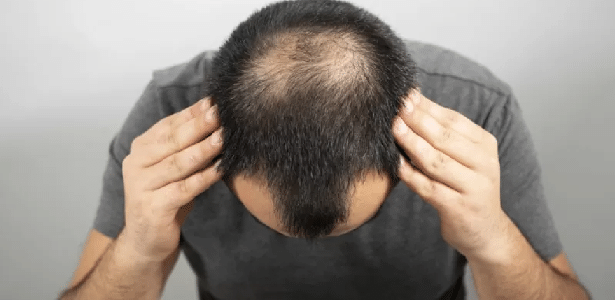
The search for baldness solutions does not come from today, but from centuries ago.
It is known that nearly 2,000 years ago, the Greek Hippocrates – who is considered the father of modern medicine because he was the first to separate his scientific observations from the religious beliefs in force at the time – began observing the performance of poetry, and testing methods of reversing it. his fall.
Although we now understand better how the hair system works, there are still many misconceptions that are repeated about hair loss — that it “isn’t necessarily a bad thing,” says Carolyn Goh, a dermatologist who specializes in hair loss and scalp disorders. .
In addition to researching this part of the body at the University of California, Los Angeles (UCLA), Goh in particular has been diagnosed with alopecia areata, which occurs when the immune system attacks hair follicles.
In an interview with BBC News Mundo, the BBC’s Spanish-language service, the dermatologist points out three persistent myths about baldness.
Myth 1: The mother’s genes are the cause
You may have heard that the genes that cause baldness come from the maternal side of the family, but the reality is much more complex than that.
A 2017 study published in the British journal PLOS Genetics analyzed information from 52,000 men with androgenetic alopecia and claimed that they were able to identify at least 287 genes involved in the hair loss process.
At least 40 of the genes identified were linked to the X chromosome, the gene inherited from the mother, while the others were scattered throughout the genome.
“It’s true that stronger genes come from the mother’s family side, but because more than one gene causes baldness, it can come from both sides. So it’s likely to come from both sides,” Goh says.
According to the doctor, the genes identified as responsible for baldness cause hypersensitivity to an ingredient found in testosterone, which is the male hormone. It’s something that can happen in both men and women, but with differences.
“Women generally don’t go bald. They generally lose some hair on their heads and maybe a little bit at the temples. That’s probably because we don’t have as much testosterone as men, and we have more estrogen to balance it out.”
Myth 2: Wearing a hat or washing your hair too often can increase hair loss
How many times do you wash your hair a week? every day? three times a week? Do you often wear a cap or hat?
Perhaps none of this has anything to do with your hair loss.
“Sure, if you see someone covering their head, it’s because they’re bald, not the other way around,” Goh jokes.
These myths relate to something real: The scalp is one of the oiliest areas of skin.
“It is one of the fattest areas, but not necessarily the most sensitive. In fact, fewer allergies are reported in the scalp than in other parts of the body,” says the expert.
The doctor claims that if a person uses the right products, they should have no problem washing their hair every day.
Myth 3: There is no proven solution to hair loss
Currently, there are at least three clinically proven alternatives to fight baldness.
None of them guarantee 100% effective results, given the complex chemical and biological system involved in hair loss, but they can help slow or even reverse it – remember that you should never start treatment with medication without medical advice.
- Minoxidil: It is a compound sold as a lotion or foam that is applied directly to the scalp. Recently, it also won the tablet version.🇧🇷
- Finasteride: applied orally. It was originally used to treat a type of benign prostatic hyperplasia but now in low concentrations it prevents hair loss;
- Planting: Generally, hair follicles are removed from the part of the head where hair continues to grow and inserted into the parts where there is no further growth. Various implant techniques have evolved a lot in recent years.
About this last treatment, Dr. Goh says there is still hesitation about its effectiveness, but she assures that “today’s implants are really good.”
Because of the level of precision the procedure requires—individual follicles must be removed and reinserted—Goh recommends that the transplant be performed by someone with “good eyes.”
“There is a lot of artistry in it. What is amazing is that the follicle ‘remembers’ how it grew before it was transplanted. [geralmente na parte de trás da cabeça] and be able to grow in the new location.”
– This text was published in https://www.bbc.com/portuguese/geral-63868424

“Proud explorer. Freelance social media expert. Problem solver. Gamer.”


:strip_icc()/i.s3.glbimg.com/v1/AUTH_59edd422c0c84a879bd37670ae4f538a/internal_photos/bs/2024/x/A/NeqsKDRqqn9veJRY9Bfg/2024-05-12t162845z-1283238058-rc23p7aj3vw6-rtrmadp-3-israel-palestinians-gaza.jpg)

:strip_icc()/i.s3.glbimg.com/v1/AUTH_59edd422c0c84a879bd37670ae4f538a/internal_photos/bs/2024/l/P/u5s3L1R0GlUwnuGXHzrg/2024-02-09t010056z-1671682486-rc2ny5afvf56-rtrmadp-3-usa-biden.jpg)

:strip_icc()/i.s3.glbimg.com/v1/AUTH_59edd422c0c84a879bd37670ae4f538a/internal_photos/bs/2024/T/G/JijQSySj6BnN4QESyqnA/2024-05-06t194110z-1158660249-rc24l7ae45s4-rtrmadp-3-israel-palestinians-hamas-agreement.jpg)